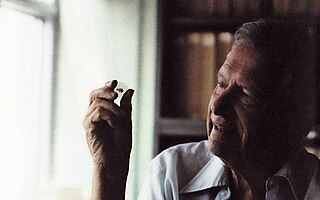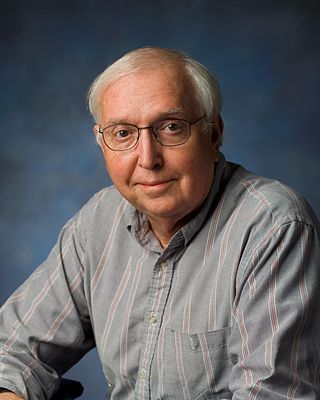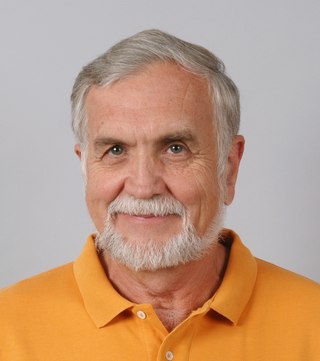Related Research Articles

Meteor Crater, or Barringer Crater, is an impact crater about 37 mi (60 km) east of Flagstaff and 18 mi (29 km) west of Winslow in the desert of northern Arizona, United States. The site had several earlier names, and fragments of the meteorite are officially called the Canyon Diablo Meteorite, after the adjacent Canyon Diablo.

An impact event is a collision between astronomical objects causing measurable effects. Impact events have been found to regularly occur in planetary systems, though the most frequent involve asteroids, comets or meteoroids and have minimal effect. When large objects impact terrestrial planets such as the Earth, there can be significant physical and biospheric consequences, as the impacting body is usually traveling at several kilometres a second, though atmospheres mitigate many surface impacts through atmospheric entry. Impact craters and structures are dominant landforms on many of the Solar System's solid objects and present the strongest empirical evidence for their frequency and scale.

Eugene Merle Shoemaker was an American geologist. He co-discovered Comet Shoemaker–Levy 9 with his wife Carolyn S. Shoemaker and David H. Levy. This comet hit Jupiter in July 1994: the impact was televised around the world. Shoemaker also studied terrestrial craters, such as Barringer Meteor Crater in Arizona, and along with Edward Chao provided the first conclusive evidence of its origin as an impact crater. He was also the first director of the United States Geological Survey's Astrogeology Research Program.

Philip Russel Christensen is a geologist whose research interests focus on the composition, physical properties, processes, and morphology of planetary surfaces, with an emphasis on Mars and the Earth. He is currently a Regents' Professor and the Ed and Helen Korrick Professor of Geological Sciences at Arizona State University (ASU).

An ejecta blanket is a generally symmetrical apron of ejecta that surrounds an impact crater; it is layered thickly at the crater's rim and thin to discontinuous at the blanket's outer edge. The impact cratering is one of the basic surface formation mechanisms of the solar system bodies and the formation and emplacement of ejecta blankets are the fundamental characteristics associated with impact cratering event. The ejecta materials are considered as the transported materials beyond the transient cavity formed during impact cratering regardless of the state of the target materials.
The Buseck Center for Meteorite Studies was founded in 1960, on the Tempe Campus of Arizona State University, and houses the world's largest university-based meteorite collection. The collection contains specimens from over 1,600 separate meteorite falls and finds, and is actively used internationally for planetary, geological and space science research. The Center also operates a meteorite museum which is open to the public.

Brian Harold Mason was a New Zealand geochemist and mineralogist who was one of the pioneers in the study of meteorites. He played a leading part in understanding the nature of the Solar System through his studies of meteorites and lunar rocks. He also examined and classified thousands of meteorites collected from Antarctica.

David Stewart McKay was chief scientist for astrobiology at the Johnson Space Center. During the Apollo program, McKay provided geology training to the first men to walk on the Moon in the late 1960s. McKay was the first author of a scientific paper postulating past life on Mars on the basis of evidence in Martian meteorite ALH 84001, which had been found in Antarctica. This paper has become one of the most heavily cited papers in planetary science. The NASA Astrobiology Institute was founded partially as a result of community interest in this paper and related topics. He was a native of Titusville, Pennsylvania.

Peter H. Schultz is Professor of Geological Sciences at Brown University specializing in the study of planetary geology, impact cratering on the Earth and other objects in the Solar System, and volcanic modifications of planetary surfaces. He was co-investigator to the NASA Science Mission Directorate spacecraft Deep Impact and the Lunar Crater Observation and Sensing Satellite (LCROSS). He was awarded the Barringer Medal of the Meteoritical Society in 2004 for his theoretical and experimental studies of impact craters.

Laurie Leshin is an American scientist and academic administrator serving as the 10th Director of the NASA Jet Propulsion Laboratory and as Vice President and Bren Professor of Geochemistry and Planetary Science at California Institute of Technology. Leshin's research has focused on geochemistry and space science. Leshin previously served as the 16th president of Worcester Polytechnic Institute.

Ronald Greeley was a Regents’ Professor in the School of Earth and Space Exploration (SESE) at Arizona State University (ASU), the Director of the NASA-ASU Regional Planetary Image Facility (RPIF), and Principal Investigator of the Planetary Aeolian Laboratory at NASA-Ames Research Center. He was involved with lunar and planetary studies since 1967 and most recently focused his research on understanding planetary surface processes and geologic histories.
Stuart Ross Taylor was a New Zealand geochemist and planetary scientist known for his studies of the geology of the Moon through lunar samples, the continental crust, tektites and the evolution of the Solar System. He was an emeritus professor and Visiting Fellow at the Australian National University in Canberra. He died in Canberra on 23 May 2021 at the age of 95.

Planetary science is the scientific study of planets, celestial bodies and planetary systems and the processes of their formation. It studies objects ranging in size from micrometeoroids to gas giants, with the aim of determining their composition, dynamics, formation, interrelations and history. It is a strongly interdisciplinary field, which originally grew from astronomy and Earth science, and now incorporates many disciplines, including planetary geology, cosmochemistry, atmospheric science, physics, oceanography, hydrology, theoretical planetary science, glaciology, and exoplanetology. Allied disciplines include space physics, when concerned with the effects of the Sun on the bodies of the Solar System, and astrobiology.

Meenakshi Wadhwa is a planetary scientist and educator who studies the formation and evolution of the Solar System through the analysis of planetary materials including meteorites, Moon rocks and other extraterrestrial samples returned by spacecraft missions. She is director of the School of Earth and Space Exploration at Arizona State University.

Lindy Elkins-Tanton is an American planetary scientist and professor whose research concerns terrestrial planetary evolution. She is the Principal Investigator of NASA's Psyche mission to explore the metallic asteroid 16 Psyche, Arizona State University Vice President of the Interplanetary Initiative, and co-founder of Beagle Learning, a tech company training and measuring collaborative problem-solving and critical thinking.
Extinct isotopes of superheavy elements are isotopes of superheavy elements whose half-lives were too short to have lasted through the formation of the Solar System, and because they are not replenished by natural processes, can nowadays only be found as their decay products trapped within sediment and meteorite samples dating billions of years ago.

The Korea Pathfinder Lunar Orbiter (KPLO), officially Danuri, is South Korea's first lunar orbiter. The orbiter, its science payload and ground control infrastructure are technology demonstrators. The orbiter will also be tasked with surveying lunar resources such as water ice, uranium, helium-3, silicon, and aluminium, and produce a topographic map to help select future lunar landing sites.
Ghislaine Crozaz is a cosmochemist known for her research on the early history of the solar system through tracking trace elements in meteorites.
The School of Molecular Sciences is an academic unit of The College of Liberal Arts and Sciences at Arizona State University (ASU). The School of Molecular Sciences (SMS) is responsible for the study and teaching of the academic disciplines of chemistry and biochemistry at ASU.
References
- ↑ "Carleton Moore serves as ASU's meteorite studies founding father". The Arizona State Press. Retrieved 2022-01-03.
- ↑ Moore, Carleton B.; Lewis, Charles F.; Gibson, Everett K.; Nichiporuk, Walter (1970-01-30). "Total Carbon and Nitrogen Abundances in Lunar Samples". Science. 167 (3918): 495–497. Bibcode:1970Sci...167..495M. doi:10.1126/science.167.3918.495. ISSN 0036-8075. PMID 17781467. S2CID 28516718.
- 1 2 3 Klemaszewski, James (2021-10-06). "Celebrating ASU history: Carleton Moore, meteorites and moon rocks". ASU News. Archived from the original on 2021-10-06. Retrieved 2022-01-03.
- ↑ Kvenvolden, Keith; Lawless, James; Pering, Katherine; Peterson, Etta; Flores, Jose; Ponnamperuma, Cyril; Kaplan, I. R.; Moore, Carleton (1970). "Evidence for Extraterrestrial Amino-acids and Hydrocarbons in the Murchison Meteorite". Nature. 228 (5275): 923–926. Bibcode:1970Natur.228..923K. doi:10.1038/228923a0. ISSN 1476-4687. PMID 5482102. S2CID 4147981.
- ↑ "5046 Carletonmoore Asteroid Facts". www.universeguide.com. 27 March 2019. Retrieved 2022-01-03.
- ↑ "Mineral 'carletonmooreite' named for founder of ASU Center for Meteorite Studies". ASU News. 2021-02-15. Retrieved 2022-01-03.
- ↑ Moore, Carleton B. (1960). I. The kinetics of the reactions of silver, lead, and thallium with thioacetamide. II. The distribution of barium, titanium, manganese, chromium, iron, nickel and cobalt in stony meteorites (phd thesis). California Institute of Technology.
- ↑ "History - Center for Meteorite Studies". Archived from the original on 2013-04-21.
- ↑ "Dr. Carleton Moore, University Portrait". azmemory.azlibrary.gov. Retrieved 2022-01-03.
- ↑ "Fellows". meteoritical.org. Retrieved 2022-01-03.
- ↑ Wasserburg, G. J. (1988). "Tribute to Carleton Moore". Meteoritics. 23 (1): 97. Bibcode:1988Metic..23...97W. doi:10.1111/j.1945-5100.1988.tb00902.x. ISSN 0026-1114.
- ↑ "Welcome to the Emeritus College at ASU | The Emeritus College". emerituscollege.asu.edu. Retrieved 2022-01-03.
- ↑ "Emeritus | School of Molecular Sciences". sms.asu.edu. Retrieved 2022-01-03.
- ↑ "Professors Emeriti | School of Earth and Space Exploration". sese.asu.edu. Retrieved 2022-01-03.